Golden-billed Saltator
Photo by Patricio Herrera |
|
|
Tour ItineraryDay 0. Fly to Lima. Overnight Lima. Day 1. Early flight from Lima to Cajamarca. We head directly for Otuzco where we look for Gray-bellied Comet; our first North Peru Endemic (NPE). Also possible White-tailed Shrike-Tyrant, Black Metaltail (Peru Endemic; PE), Bronze-tailed Comet (PE), Rusty-crowned Tit-Spinetail (PE
), White-winged Cinclodes, Pied-crested and Yellow-billed Tit-Tyrant and Giant Hummingbird. In the afternoon we return for dinner and overnight at our comfortable hotel in Cajamarca.
Day 2. Early start as we have a 2 hour drive to our birding destination at Cruz Conga. We hope to see the cajamarcae race of Rufous Antpitta most likely to become a new species;
Black-necked Woodpecker
Photo by Roger Ahlman |
|
|
Cajamarca Antpitta. Also another chance for the rare White-tailed Shrike-Tyrant, Jelski's Chat-Tyrant, Plain-tailed Warbling-Finch (PE) and Rufous-eared Brush-Finch (PE).Dinner and overnight in Celendin. Day 3.
A spectacular day awaits us. The views are mind-blowing as we descend into the Marañon river basin; a gorge wider than the Grand Canyon. We look for Chestnut-backed Thornbird, Gray-winged and Buff-bridled Inca-Finch and Yellow-faced Parrotlet; all endemic to northern Peru. Other possibilities include Maranon Thrush, Black-lored Yellowthroat and Striped Cuckoo. We bird our way back to Celendin and at one
of our stake-outs we search for Jelski's Chat-Tyrant, Baron's Spinetail (NPE), Bar-bellied Woodpecker and Tawny-rumped Tyrannulet. Dinner and overnight in Celendin. Day 4. Today is a bit of a traveling day but there will be plenty of time for birding and photographing. Rufous-naped Ground-Tyrant and Grassland Yellow-Finch are possible and we get a second chance on Yellow-faced Parrotlet. At Balsas we cross the Maranon river
and ascend the steep eastern slope. Later we reach the pass at Abra Barro Negro where we hope for Coppery Metaltail (PE), White-chinned (Peruvian) Thistletail (NPE), Blackish Tapaculo (race intermedius that might be a split), and Moustached Flowerpiercer. Dinner and overnight at Leymebamba.  Back to top Back to top 
Day 5. Early start as we re-trace our tracks back to Abra Barro Negro. In the small forest patches we look for Russet-mantled Softtail (NPE), White-capped Tanager, Rainbow Starfrontlet, Gray-breasted Mountain-Toucan, the obscura race of Rufous Antpitta
(possible split), and a good chance for mixed species flocks. We return to Leymebamba and continue towards Hacienda El Chillo, birding our way through another breathtaking canyon; the Utcubamba river valley. We make several stops for Torrent Duck, Peruvian Pigeon, Black-necked Woodpecker (PE) and Buff-bellied Tanager. Dinner and overnight at Hacienda El Chillo. Day 6. In the morning we bird around El Chillo. The rare Little Woodstar has been seen a
few times in their garden, together with Andean Emerald and Spot-throated Hummingbird. We then have a couple of hours drive to Pomacochas, also called Florida. Here we visit a lek of one of South Americas most amazing birds; Marvellous Spatuletail (NPE). It is a hummingbird well worth its name! Displaying males wield their rackets like medieval knights jousting for their damsels, while their gorgets flare like gems in the
undergrowth. Other worthy birds include Rufous-capped Antshrike, Silver-backed Tanager and a chance on the rare Chestnut-crested Cotinga. Late afternoon we arrive at our Hotel situated next to lake Pomacochas. Possible in the marshy fields and surrounding reed beds are Puna Snipe, Plumbeous Rail, Grassland Yellow-Finch, Peruvian Meadowlark and the rare Subtropical Doradito. Dinner and overnight at Hotel Pomacochas.
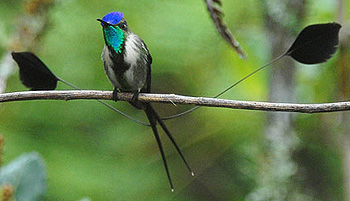
Marvelous Spatuletail
Photos by Roger Ahlman | 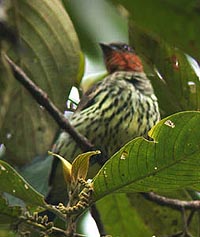
Chestnut-crested Cotinga
|
| Day 7.
Early morning start as we get our first taste of the lush cloudforests of Cordillera del Colan, home to one of South Americas most mythical birds; the Long-whiskered Owlet (NPE). The whole area holds a list of over 420 species so the possibilities are plenty. At Abra Patricia we look for Royal Sunangel (NPE) dressed in royal blue; the recently described Lulu's Tody-Tyrant (NPE), Bar-winged Wood-Wren, White-capped and Yellow-scarfed
Tanager (PE), three species of Antpittas; Ochre-fronted (NPE), Chestnut (PE) and Rusty-tinged (NPE). Long-whiskered Owlet (Xenoglaux), seen and tape-recorded recently only 50m from the lodge! We will stay at the new ECOAN Lodge at Abra Patricia for 3 nights. After dusk we have a stake-out for the rare Cinnamon Screech-Owl and a slight chance on the rare Andean Potoo.
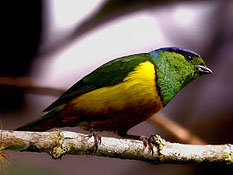
Chestnut-breasted Chlorophonia
Photo by Patricio Herrera
| 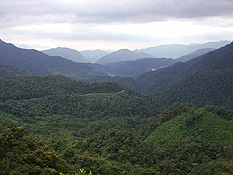
Abra Patricia
Photo by Roger Ahlman
|
| Versicolored Barbet
Photo by Pete Oxford |
|
|
Day 8. We continue to bird the Cordillera del Colan, exploring the lower elevations around Afluentes for mixed species flocks. Several gaudy Tanagers mingle together
with Versicolored Barbet, Speckle-chested Piculet (NPE), Equatorial Graytail, Buff-fronted Foliage-gleaner and Gray-mantled Wren. More skulkers await us and with luck we might see Chestnut-crowned Gnateater, Black-and-white Tody-Flycatcher, White-crowned Tapaculo and Chestnut-breasted Wren.
Dinner and night at Abra Patricia Lodge. Day 9. All day in the Colan area enjoying its birds and forest. Vermilion Tanager, Emerald-bellied Puffleg, White
-eared Solitaire, Peruvian Wren (PE) are just a few more possibilities. Dinner and overnight at Abra Patricia Lodge.  Back to top Back to top 
Day 10. Morning birding in the Abra Patricia area before we head west. We have a fairly long drive to Bagua Chica in the Marañon desert. Plenty of stops though with Long-tailed Mockingbird, Saffron Finch, Croaking Ground-Dove, Northern Crested-Caracara among others. Dinner and overnight in Bagua Chica. 
Rufous Flycatcher
Photo by Roger Ahlman
| 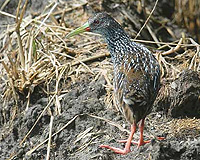
Spotted Rail
Photo by Roger Ahlman
|
|
Maranon Crescentchest
Photo by Patricio Herrera |
|
|
Day 11. At first light, in a beautiful desert just outside Bagua Chica, we search for Little Inca-Finch (NPE). Other birds here include Maranon Crescentchest, Lesser Nighthawk, Tropical Gnatcatcher (possible split; Maranon
Gnatcatcher), Mouse-colored Tyrannulet, Red Pileated-Finch and overflying Scarlet-fronted Parakeets.
Later, before the sun becomes unbearable, we check some ponds for Rufous-sided Crake, Spotted Rail and Comb Duck. After lunch we head towards Jaen, further west. Late afternoon, we search the rice-fields for Paint-billed and Gray-breasted Crake and Spotted Rail. West Peruvian Screech-Owl
Photo by Roger Ahlman |
|
|
Dinner and overnight in Jaen.Day 12. Morning birding just outside Jaen for Tataupa Tinamou, Marañon Slaty-Antshrike, Drab Seedeater, Chinchipe Spinetail (NPE) and another chance for Maranon Crescentchest. Later we search for the cryptic Marañon Spinetail. Also here are Maranon Thrush, Brown-crested
Flycatcher and chances on several species of raptors. In the afternoon we bird our way to Olmos looking for Bare-faced Ground-Dove and Andean Condor along the way. Dinner and overnight in Olmos. Day 13. Early start and we head back east to the lowest pass in the northern Andes - Abra Porculla - a great place for tumbesian endemics. We hope to encounter Rufous-necked and Henna-hooded Foliage
-gleaner, Piura Chat-Tyrant (PE), Black-cowled Saltator, Line-cheeked Spinetail, Chapman's Antshrike, Three-banded Warbler, Ecuadorian Piculet, Bay-crowned and White-winged Brush-Finch and Gray-chinned Hermit (possible split; Porculla Hermit). After Porculla pass we return to Olmos for an afternoon visit to the Guan center. Close by is a day-roost for Striped Owl. Dinner and overnight in Olmos.  Back to top Back to top 
Tumbes Hummingbird
Photo by Janos Olah Jr. |
Burrowing Owl
Photo by Anders Paulsrud |
|
White-headed Brush-Finch
Photo by Patricio Herrera |
|
|
Day 14. A very early start as we traverse the Pampa de Olmos. On the way we look for Anthony's Nighjar, West Peruvian Screech-Owl and Pacific Pygmy-Owl. Reaching
Limon before sunrise our local guide takes us swiftly through the famous Guan-valley. Long thought extinct, the White-winged Guan was rediscovered here in the late 70's. With some luck we should find it here. Many Tumbesian endemics are present such as Tumbes Hummingbird, Tumbes Tyrant (NPE), Tumbes Sparrow, White-headed Brush-Finch, White-tailed Jay as well as Ecuadorian Trogon, Guayaquil Woodpecker, Pacific Elaenia, Speckle-breasted Wren and
King Vulture. In the afternoon we return to Olmos and continue to Chiclayo.
Dinner and overnight in Chiclayo. Day 15. We have an hour drive to Bosque Pomac, our morning destination. This reserve protects an extensive area of Mesquite Forest with some very unique species. Peruvian Plantcutter (NPE) and Rufous Flycatcher (NPE) are still fairly common here, both very rare in general due to deforestation and overgrazing. This place provides excellent birding and
we continue looking for Peruvian Thick-knee, Coastal Miner (PE), Scarlet-backed Woodpecker, Short-tailed Woodstar, Oasis Hummingbird, Necklaced Spinetail, Tumbes Swallow, Cinereous Finch (PE) and White-edged Oriole among others. Afternoon drive to Chaparrí with possible Andean Ibis along the way. Dinner and overnight at Chaparrí. White-winged Guan
Photo by Roger Ahlman |
|
|
|
Day 16. Chaparrí is a private reserve with an extensive Mesquite forest. It is one of the best places to see Tumbes Tyrant (PE) and Sulphur-throated Finch. Ochre-bellied Dove is
also possible here. Afternoon drive to Chiclayo for an evening flight to Lima. Dinner and overnight in Lima. Day 17. Flight home. Looking forward to see you in Northern Peru! Giant Hummingbird
Photo by Roger Ahlman |
|
|
|
 Back to top Back to top 
Tour Information Price per person: Click here for prices
Included: All lodging, meals, expert bilingual birdguide, transportation, internal flights (Lima-Cajamarca, Chiclayo-Lima), hotel transfer and entrance fees.
Not included: Last night dinner; drinks; tips.
See our Payment and Cancellation Policy page for important information.
|